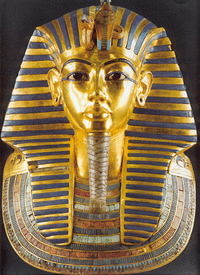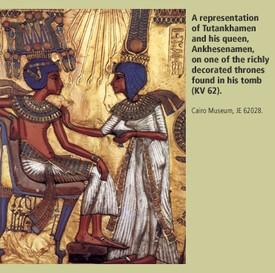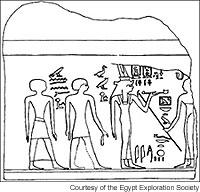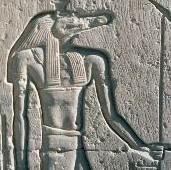Historia Antiqua -Ancient Egypt

This Web site is a treasure in itself waiting to be discovered when it comes to the young Egyptian pharaoh Tutankhamen and what was discovered in his tomb, which has proved to be the most amazing discovery in the history of archeology. Archeologists learned that Tut died young, around 19 years old, and he was buried with incredible treasures made from gold, ivory, wood, and semi-precious stones. They even placed a chariot in the tomb for him to use in the afterlife. Click on the many links for more pictures of the treasures, who discovered it, and much more.
Topic: Tutankhamen (King Tut) Language: English Lexile: 950 http://www.timetrips.co.uk
Ancient Egypt
Most scholars believe Tutankhamen was the son of the ruler Akhetaten because he was given the title of “King’s Son,” and he grew up in his palace. Tutankhamen was only 7 or 8 years old when he started his reign in 1343, and he ruled for only ten years until his death in 1333 B.C. Howard Carter is credited for discovering his tomb in 1922, which was filled with all the things the young king would need in the afterlife. Also listed are the names of important officials from King Tutankhamen’s reign.
Topic: Tutankhamen (King Tut) Language: English Lexile: 980 Image collection http://euler.slu.edu

More people are familiar with the name Tutankhamen than any other Egyptian ruler, primarily because of the opulent content of his tomb, but also because of his age when he died. He was only a boy when he rose to the throne, and he only ruled for ten years. Some think Tutankhamen died under suspicious circumstances because of the turmoil in his family and court. View the diagram of Tutankhamen’s tomb, reconstructed in the way the contents were discovered in 1922.
Topic: Tutankhamen (King Tut) Language: English Lexile: 1330 http://carlos.emory.edu
Religion in Ancient Egypt: Gods and Goddesses
Egypt's Golden Empire: Religion
In Ancient Egypt, the mysteries of nature and the worries of everyday life were explained in stories about the gods. Egyptians had hundreds of local and national gods whom they believed were responsible for things like childbirth, the spread of diseases, and the rising and setting sun. They didn't know why the tide happened or why crops failed. They blamed it on gods and goddesses. Egyptians thought that by honoring the gods they could control these phenomena. Maat was the order of the universe. The pharaoh was responsible for keeping everything in order and preventing chaos.
Topic: Egyptian mythology Language: English Lexile: 1030 Video http://www.pbs.org
Hatshepsut: Wicked Stepmother or Joan of Arc?

The Brothers Grimm influenced historians to immortalize the Egyptian female rule Hatshepsut as a wicked stepmother to the young King Tuthmose III. It’s historical fact that she was indeed his stepmother, but new facts have been unearthed that have changed historians perception of her. Tuthmose III is responsible for erasing and re-carving Hatshepsut’s monuments, so it was assumed that he did it out of revenge for her usurping his throne. But they learned that the re facing of her monuments took place 20 years after her death, and revenge surely wouldn’t take that long for someone in power.
Topic: Hatshepsut, Queen of Egypt, Ancient Egypt--New Kingdom, ca. 1550-ca. 1070 BCE Lexile: 1450
http://fathom.lib.uchicago.edu

In ancient Egypt, people did not see death as the end to life. Death was an entry to paradise. It was very important to prepare the dead person's body for the afterlife. All of the articles presented on this site are about ancient Egyptians and the afterlife. You can read about mummies, tombs, mummy cases, and funerary objects that were buried along with the person who died. If you are interested in archaeology, then read the section on excavation to learn how archaeologists study and document artifacts.
Topic: Mummies, Egypt--Social life and customs, Tombs--Egypt Lexile: 1260 Interactive http://www.mos.org
Egyptian Art (3100 BCE - 395 CE)
Long before the Greeks, the Egyptians were making art in the Mediterranean. They built pyramids, wrote in hiero-glyphics, and carved images in stone. Art served to honor the gods and the pharaohs. It was about propaganda and the after-life. Sculptors, painters, and artisans worked as a team under the direction of a master craftsman or architect, but the patron got the credit. Discover the rules for figures in individual and group portraits. Colors were also symbolic. Funerary art found in tombs included frescoes, relief carvings, and models.
Topic: Egyptian art Language: English Lexile: 1400 http://www.visual-arts-cork.com

Sunken Relief Sculpture of the crocodile god Sobek (c.100 BCE)
Sculpted for the Temple of Kom Ombo
- EResources
- Ebooks
- Contests and Opportunities
- Faculty Resources
- Library Good Reads
- GradPoint (opens in new window)
- LibGuides
- NHS Library Seminars (opens in new window)
-
Historical Links
- Immigrant Groups in the West
- Immigrant Groups in the West Making the Connections
- Immigration Symbols
- Immigration West
- Industrial Revolution Resources List
- Industrialists
- Korean War
- Legacy of Jim Crow
- The 60's
- Women and the Industrial Revolution
- Working Women and the Industrial Revolution
- Working Women During the Industrial Revolution
- Against Slavery
- Immigration
- Louis Braille An Exceptional Man
- MLA and APA Style Guides
- Norwood High School Home
- Quick reference
- Research & Instruction
- Summer Work
- Textbooks
This site provides information using PDF, visit this link to download the Adobe Acrobat Reader DC software.
